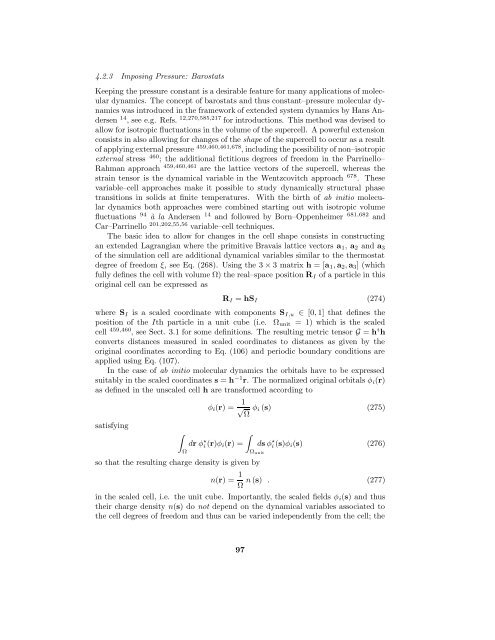Ab initio molecular dynamics: Theory and Implementation
Ab initio molecular dynamics: Theory and Implementation
Ab initio molecular dynamics: Theory and Implementation
- No tags were found...
Create successful ePaper yourself
Turn your PDF publications into a flip-book with our unique Google optimized e-Paper software.
4.2.3 Imposing Pressure: BarostatsKeeping the pressure constant is a desirable feature for many applications of <strong>molecular</strong><strong>dynamics</strong>. The concept of barostats <strong>and</strong> thus constant–pressure <strong>molecular</strong> <strong>dynamics</strong>was introduced in the framework of extended system <strong>dynamics</strong> by Hans Andersen14 , see e.g. Refs. 12,270,585,217 for introductions. This method was devised toallow for isotropic fluctuations in the volume of the supercell. A powerful extensionconsists in also allowing for changes of the shape of the supercell to occur as a resultof applying external pressure 459,460,461,678 , including the possibility of non–isotropicexternal stress 460 ; the additional fictitious degrees of freedom in the Parrinello–Rahman approach 459,460,461 are the lattice vectors of the supercell, whereas thestrain tensor is the dynamical variable in the Wentzcovitch approach 678 . Thesevariable–cell approaches make it possible to study dynamically structural phasetransitions in solids at finite temperatures. With the birth of ab <strong>initio</strong> <strong>molecular</strong><strong>dynamics</strong> both approaches were combined starting out with isotropic volumefluctuations 94 à la Andersen 14 <strong>and</strong> followed by Born–Oppenheimer 681,682 <strong>and</strong>Car–Parrinello 201,202,55,56 variable–cell techniques.The basic idea to allow for changes in the cell shape consists in constructingan extended Lagrangian where the primitive Bravais lattice vectors a 1 , a 2 <strong>and</strong> a 3of the simulation cell are additional dynamical variables similar to the thermostatdegree of freedom ξ, see Eq. (268). Using the 3 × 3 matrix h = [a 1 ,a 2 ,a 3 ] (whichfully defines the cell with volume Ω) the real–space position R I of a particle in thisoriginal cell can be expressed asR I = hS I (274)where S I is a scaled coordinate with components S I,u ∈ [0, 1] that defines theposition of the Ith particle in a unit cube (i.e. Ω unit = 1) which is the scaledcell 459,460 , see Sect. 3.1 for some def<strong>initio</strong>ns. The resulting metric tensor G = h t hconverts distances measured in scaled coordinates to distances as given by theoriginal coordinates according to Eq. (106) <strong>and</strong> periodic boundary conditions areapplied using Eq. (107).In the case of ab <strong>initio</strong> <strong>molecular</strong> <strong>dynamics</strong> the orbitals have to be expressedsuitably in the scaled coordinates s = h −1 r. The normalized original orbitals φ i (r)as defined in the unscaled cell h are transformed according tosatisfying∫Ωφ i (r) = 1 √Ωφ i (s) (275)∫dr φ ⋆ i (r)φ i (r) =Ω unitso that the resulting charge density is given byds φ ⋆ i (s)φ i (s) (276)n(r) = 1 n (s) . (277)Ωin the scaled cell, i.e. the unit cube. Importantly, the scaled fields φ i (s) <strong>and</strong> thustheir charge density n(s) do not depend on the dynamical variables associated tothe cell degrees of freedom <strong>and</strong> thus can be varied independently from the cell; the97









